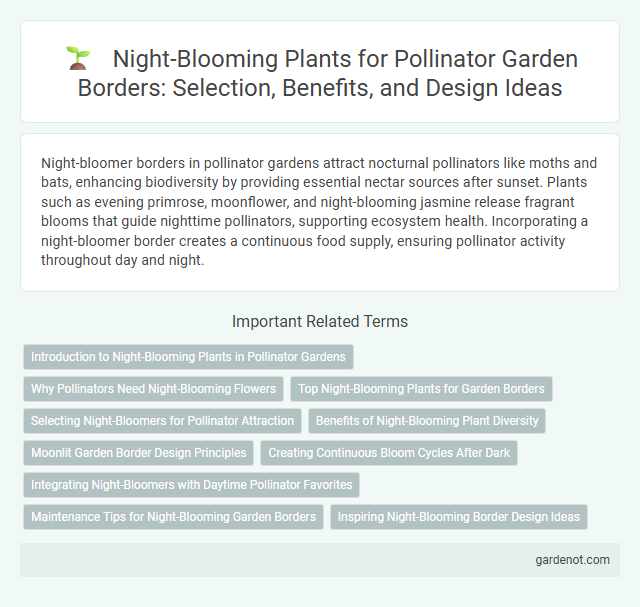Night-bloomer borders in pollinator gardens attract nocturnal pollinators like moths and bats, enhancing biodiversity by providing essential nectar sources after sunset. Plants such as evening primrose, moonflower, and night-blooming jasmine release fragrant blooms that guide nighttime pollinators, supporting ecosystem health. Incorporating a night-bloomer border creates a continuous food supply, ensuring pollinator activity throughout day and night.
Introduction to Night-Blooming Plants in Pollinator Gardens
Night-blooming plants play a crucial role in pollinator gardens by attracting nocturnal pollinators such as moths, bats, and night-active bees. These plants often emit strong fragrances and display pale or white flowers, enhancing visibility and scent detection in low light. Incorporating a night-bloomer border increases biodiversity and supports the ecosystem during nighttime hours when most traditional pollinator plants are dormant.
Why Pollinators Need Night-Blooming Flowers
Night-blooming flowers provide essential nectar and pollen sources for nocturnal pollinators such as moths, bats, and certain beetles, supporting biodiversity in pollinator gardens. These flowers release strong fragrances and exhibit pale or white colors to attract pollinators in low-light conditions, enhancing pollination efficiency during nighttime hours. Incorporating a night-bloomer border increases habitat diversity and ensures continuous food availability for pollinators beyond daylight, promoting ecosystem health.
Top Night-Blooming Plants for Garden Borders
Night-blooming plants such as Nicotiana alata, Evening Primrose (Oenothera biennis), and Moonflower (Ipomoea alba) thrive along garden borders, attracting moths and other nocturnal pollinators. These plants release strong fragrances after dusk, enhancing pollinator activity and supporting biodiversity in nighttime garden ecosystems. Incorporating species like Four o'Clock (Mirabilis jalapa) ensures continuous blooms through the evening, creating an inviting habitat for pollinators under low light conditions.
Selecting Night-Bloomers for Pollinator Attraction
Choosing night-blooming plants such as evening primrose, moonflower, and night-blooming jasmine enhances pollinator gardens by attracting nocturnal pollinators like moths and bats. Selecting species with strong fragrances and pale or white flowers increases visibility and scent diffusion at night, improving pollination efficiency. Incorporating diverse night-bloomers ensures continuous nectar supply, supporting a wide range of nighttime pollinators and promoting ecosystem health.
Benefits of Night-Blooming Plant Diversity
Night-blooming plants in pollinator gardens attract nocturnal pollinators such as moths, bats, and night-active beetles, enhancing biodiversity and ecological balance. These plants extend pollination activity beyond daylight hours, increasing pollination efficiency and supporting a wider range of species. Incorporating a diverse selection of night-bloomers boosts habitat complexity and promotes year-round garden resilience.
Moonlit Garden Border Design Principles
Night-bloomer border in pollinator gardens prioritizes plants that release fragrance and nectar at dusk, attracting nocturnal pollinators like moths and bats. Moonlit garden border design principles emphasize using white or pale blooms to reflect moonlight, enhancing visibility and aesthetic appeal during nighttime hours. Strategically layering night-blooming species ensures continuous nectar supply and supports biodiversity in the garden ecosystem.
Creating Continuous Bloom Cycles After Dark
A night-bloomer border in a pollinator garden features plants like evening primrose, night phlox, and moonflower that open their flowers after dark, providing nectar sources for nocturnal pollinators such as moths and bats. Carefully selecting a variety of night-blooming species ensures a continuous bloom cycle throughout the warm months, supporting pollinator activity during nighttime hours. This strategy increases biodiversity and promotes round-the-clock pollination, enhancing the overall health and productivity of the garden ecosystem.
Integrating Night-Bloomers with Daytime Pollinator Favorites
Integrating night-bloomers like evening primrose and moonflower with daytime pollinator favorites such as coneflowers and bee balm creates a continuous nectar source that supports diverse pollinators around the clock. Night-blooming plants attract nocturnal pollinators including moths, bats, and certain beetles, complementing the activity of bees, butterflies, and hummingbirds active during daylight. This strategic planting enhances biodiversity, promotes ecosystem health, and extends pollination services within the garden environment.
Maintenance Tips for Night-Blooming Garden Borders
Night-bloomer borders require consistent soil moisture and well-drained conditions to promote healthy growth and vibrant nocturnal blooms. Pruning spent flowers regularly encourages continuous blooming while reducing the risk of fungal diseases common in dense foliage. Applying organic mulch helps retain soil moisture and suppress weeds, supporting pollinators like moths and bats that are attracted to night-flowering plants.
Inspiring Night-Blooming Border Design Ideas
Night-bloomer border designs enhance pollinator gardens by attracting nocturnal pollinators such as moths and bats, using fragrant white or pale-colored flowers that glow under moonlight. Plants like evening primrose, moonflower, and night-blooming jasmine create a soothing, pollinator-friendly habitat that supports biodiversity and extends garden activity into nighttime hours. Incorporating layered planting with varying heights and periods of bloom ensures continuous nectar sources through the night, optimizing pollination efficiency.
Night-bloomer border Infographic

 gardenot.com
gardenot.com